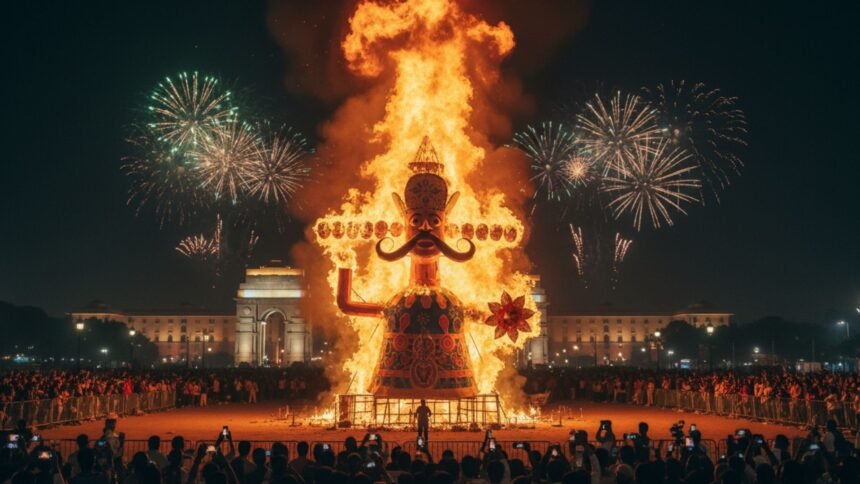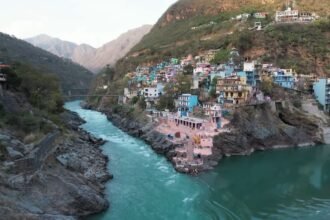New Delhi: As dusk descends on Vijayadashami, towering effigies of Ravana, Meghnath and Kumbhakarna rise above the crowds, only to be engulfed in flames amid thunderous firecrackers and cries of “Jai Shri Ram.” For millions, this spectacle is the defining image of Dussehra not merely a retelling of the Ramayana, but a collective ritual that binds communities together. Yet, the questions linger: why is Ravana burnt every year? Does the ritual really purge arrogance, or has it become a hollow formality in the guise of tradition?
Historical Roots
The Valmiki Ramayana (Uttarakanda, Chapter 108) describes Ravana’s respectful cremation after his death, but nowhere does it mention burning effigies. Hindi literary historian Hazari Prasad Dwivedi, in his seminal work Hindi Sahitya ki Bhumika (1940), argued that the popularity of Ramcharitmanas in the 16th century and the spread of Ram Lila traditions gave rise to symbolic enactments of Ravana’s fall.
Delhi University historian Anjan Sen, in his 2020 paper Itihas aur Utsav: Bharatiya Parampara, notes that public effigy burning is a post-Independence phenomenon. Refugees from Pakistan are credited with introducing collective Ravana Dahan in Ranchi and Delhi in 1948. Records of the Lav-Kush Ramlila Committee in Delhi mention that on October 17, 1953, a 15-foot effigy was burnt in the Ramlila Maidan an event that has since become emblematic of North India’s Dussehra.
Religious Symbolism
For Hindus, Vijayadashami marks the day Rama defeated Ravana the triumph of dharma over adharma. Kalidasa’s Raghuvamsha (4th century CE) also celebrates this victory as the restoration of cosmic order. Ravana is not just a mythical antagonist but an allegory of human flaws lust, anger, greed, delusion, pride, envy, sloth, injustice, and tyranny. The act of burning his effigy, therefore, is meant to remind devotees of the need to destroy these vices within.
Social and Cultural Dimensions
Tulsidas’ Ramcharitmanas elevated Rama as the Maryada Purushottam, inspiring Ramlila performances across North India. Cultural historian Ramachandra Guha, in India After Gandhi (2007), describes Ravana Dahan as “a form of collective theatricality that regenerates social values.” Delhi’s Titarpur has, for decades, been the artisanal hub where families of craftsmen sustain their livelihoods by constructing Ravana effigies a tradition that reflects both continuity and change.
Environmental Impact and Modern Responses
The grandeur of Ravana Dahan today also comes at an ecological cost. According to the Central Pollution Control Board’s 2019 report on festive air quality, Delhi’s PM2.5 levels during Dussehra spike to 150–200 µg/m³, falling into the “severe” category. Toxic gases from chemical-laden effigies including sulphur dioxide worsen respiratory risks.
Environmentalists propose alternatives that preserve symbolism without pollution. In Pune, a Ramlila committee in 2024 staged a laser show in place of effigy burning, reducing emissions by 70 per cent. Delhi’s Lav-Kush Ramlila introduced biodegradable effigies, while some groups have experimented with clay models and digital projections. “Using biodegradable materials and low-smoke pyrotechnics could cut emissions by 60 per cent,” suggested Dr. Anil Sharma of the Centre for Science and Environment (2023).
Faith and Superstition
The late Sanskrit scholar Satya Vrat Shastri observed in a 2018 lecture: “Rituals hold value only when they serve as instruments of self-purification; otherwise they degenerate into spectacle.” Increasingly, Ravana Dahan has become a contest of scale which effigy is tallest, which display most dazzling. When the ritual becomes a competition of size and fireworks, the symbolism risks being overshadowed by mere theatrics.
A Necessary Balance
The tradition of Ravana Dahan may be modern, but its message is timeless. The true effigy to burn is not the towering bamboo structure but the Ravana within arrogance, excess, and vice. As India confronts the twin demands of cultural continuity and ecological responsibility, the festival invites introspection: can faith evolve into forms that honour both the spirit of tradition and the imperative of sustainability?















